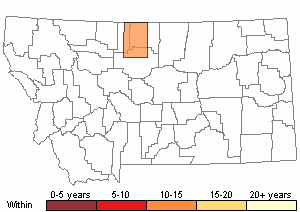View in other NatureServe Network Field Guides
NatureServe
Montana
Utah
Wyoming
Idaho
Wisconsin
British Columbia
South Carolina
Yukon
California
New York
European Pine Shoot Moth - Rhyacionia buoliana
State Rank Reason (see State Rank above)
Species is not native to Montana and therefore cannot be assigned a status rank (SNA).
General Description
The European Pine Shoot Moth is a small orange to red colored moth native to Europe. The larvae feed on the needles, buds, and branch tips of pine trees (Pinus), and are a serious pest to commercial pine plantations. Infection of host trees does not result in host death, but the propensity of the larvae to feed on the shoots and buds results in damage to the trees and is particularly detrimental to Christmas tree farms and other uses where an aesthetic appearance is important, but damage can also result in significant loss of usable lumber as well.
Diagnostic Characteristics
R. buoliana is small moth with a wingspan of approximately 19 mm, orange to red and grey coloration on the forewings and silver hindwings (Heeley et al. 2003).
Within the Rhyacionia genus, species identification based on general morphology is difficult and may require examination of the genitalia (Miller 1967). The Western Pine Tip Moth (Rhyacionia bushnelli) is native to Montana and similar in appearance to R. buoliana. Several other species of moths in this genus are found in North America and taxonomic expertise may be required to definitely identify any to species.
Host tree damage by Pine Shoot Moths is distinctive, and can be used to identify infected trees and infer presence of these species within an area. As the larvae damage the branch tips and terminal buds, infected trees develop attributes like three or more spikes in the final stem, strong crookedness or twisting that is at least 50% of the stem’s diameter, crookedness or twisting due to partial or total destruction of the tip of the previously dominant branch and subsequent dominance of a lateral branch (Miller 1967).
Range Comments
The European Pine Shoot Moth is as the common name suggests, native to Europe. However, the species has spread to parts of Asia, Africa, and the Americas through transport of wood products. The first detection of this species in North America was on Long Island, New York in 1914 and had spread to the west coast of British Columbia by 1925 and was found in the interior by 1961 (as reviewed in Heeley et al. 2003). In the United States the species is has been found in Connecticut, Delaware, Illinois, Maine, Maryland, Massachusetts, Michigan, Missouri, Nebraska, New Jersey, New York, Ohio, Oregon, Pennsylvania, Rhode Island, Vermont, Virginia, Washington, West Virginia, and Wisconsin (EPPO 2018).
To date the species has been found once in Montana. While our state has suitable host trees, the ability of this species to survive the state’s winters may limit presence and distribution as the species survival threshold is -22° C (Green 1962) and much of Montana experiences annual minimum temperatures below this threshold.r Agriculture and Bioscience International (CABI)
EDDMapS Species Information EDDMapS Species Information
Observations in Montana Natural Heritage Program Database
Number of Observations: 1
(Click on the following maps and charts to see full sized version)
Map Help and Descriptions
Relative Density

Recency


 (Observations spanning multiple months or years are excluded from time charts)
(Observations spanning multiple months or years are excluded from time charts)
Habitat
Pine Trees (Pinus) are the primary food resource for larvae, and as such habitat for this species is largely defined by the distribution of these species. Minimum temperature may also define the habitats that this species can invade as the species does not survive below -22° C (-7.6° F). In British Columbia, the absence of detections in high elevation pine forest (Lodgepole Pine, P. contorta) is hypothesized to be due to low annual minimum temperatures (Heeley et al. 2003).
Food Habits
Larvae feed on the needles and buds of pine trees (Miller 1967). Two and three needle pines are the most common host trees. In Montana, only Ponderosa Pine (P. ponderosa) occurs. The species will less frequently use Lodgepole Pine and Douglas Fir (Pseudotsuga menziesii) (Havrylenko, 1982; Godoy, 1985).
Ecology
European Pine Shoot Moth eggs are deposited by females on the twigs, buds, and needles of the host tree. Females deposit 50-150 eggs over their lifetime individually or in groups of up to four. The eggs hatch in one to two weeks with temperature being a strong determinate of this time period. Once hatched, larvae feed on the base of the needles and buds. They continue to feed in this manner through the fall. Larvae overwinter within a tent-like chamber of silk coated with resin. In the spring, larvae will migrate toward new shoots or buds and continue feeding. Over this time period, the larvae progresses through 5 instars, with the first three occurring before the winter and the last two after spring emergence. Pupation begins in the spring and continues through early to mid-summer. Adults hatch, aggregate, and mate in early to mid-summer. In interior British Columbia, eggs are deposited in July, larvae emerge in late-July. Following overwintering larvae emerge in late-April and pupate in June through early July after which adults emerge and flights occur through mid-July (Heeley et al. 2003).
Adults are strong fliers, but typically rest during the day and are only active during cooler evening temperatures between 12 and 22 C (Pointing and Green 1962). Flight by females is likely what drives dispersal of this species (Perez et al. 1999).
Management
The European Pine Moth does not kill its host trees, rather the larvae damage branch tips, increasing crookedness of the tree leading to increased stress, potential for breakage due to weather, and decreased aesthetics and usable lumber. The species is considered a serious pest of managed forests and plantations and impacts the production of ornamental trees, Christmas trees and lumber species (Lehman 1996).
The species has been recognized as a pest of pine trees in its introduced range for over a century and many strategies have been applied to outbreaks to control the species including forest management practices, biological controls, and chemical controls. As the larvae are unable to survive prolonged exposure to temperatures below -22 C, removing branches that would be insulated by snow may decrease prevalence in areas on the thermal margins of this species. Identifying and clipping infected shoots after mid- June is also recommended to reduce moth densities (Miller et al. 1970). Biological controls of this species were first introduced into North America in 1928 (Miller 1967). Between 1930 and 1962 at least 160,000 individuals of 16 species were introduced into North America. Of these four established
Orgilus obscurator,
Temelucha interruptor,
Tetrastichus turionum, and
Pimpla turionellae. Of these
O. obscurator is thought to be the most effective. Use of insecticides to control the pine shoot moth have occurred, but heavy dosages are necessary to effectively treat the needle bases and buds (Miller et al. 1970). Chemicals seem to be less commonly used to control outbreaks, it appears limited application do still occur, particularly within commercially planted forests (e.g. Heeley et al. 2003).
For information and resources on plant pests and diseases see the USDA's Animal and Plant Health Inspection Service's
Plant Pests and Diseases ProfilesUseful Links:Central and Eastern Montana Invasive Species TeamMontana Invasive Species websiteAquatic Invasive SpeciesStewardship Responsibility
References
- Literature Cited AboveLegend:
 View Online Publication
View Online Publication EPPO Global Database and GD Desktop. 2018. European and Mediterranean Plant Protection Organization. Paris, France. Accessed 20 March 2019. https://www.eppo.int/RESOURCES/eppo_databases/global_database
EPPO Global Database and GD Desktop. 2018. European and Mediterranean Plant Protection Organization. Paris, France. Accessed 20 March 2019. https://www.eppo.int/RESOURCES/eppo_databases/global_database Godoy, E. 1985. Rhyacionia buoliana Den. et Schiff. en Pseudotsuga mensziessi (Mirb) Franco. Simiente (Chile), 55(3-4):219.
Godoy, E. 1985. Rhyacionia buoliana Den. et Schiff. en Pseudotsuga mensziessi (Mirb) Franco. Simiente (Chile), 55(3-4):219. Havrilenko, D. 1982. Nueva plaga afecta a plantaciones de pino. Argentina: Diario Rio Negro, Sección Agrarias.
Havrilenko, D. 1982. Nueva plaga afecta a plantaciones de pino. Argentina: Diario Rio Negro, Sección Agrarias. Heeley, T., R.I. Alfaro, and L. Humble. 2003. Distribution and life cycle of Rhyacionia buoliana (Lepidoptera: Tortricidae) in the interior of British Columbia. Journal of the Entomological Society of British Columbia 100:19-25.
Heeley, T., R.I. Alfaro, and L. Humble. 2003. Distribution and life cycle of Rhyacionia buoliana (Lepidoptera: Tortricidae) in the interior of British Columbia. Journal of the Entomological Society of British Columbia 100:19-25. Miller, W. 1967. The European Pine Shoot Moth. Ecology and Control in the Lake States. Forest Science Monographs 14:1-72
Miller, W. 1967. The European Pine Shoot Moth. Ecology and Control in the Lake States. Forest Science Monographs 14:1-72 Miller, W.E., A.R. Hastings, and V.M. Carolin. 1970. European pine shoot moth. USDA Forest Service, Forest Pest Leaflet 59. 8 p.
Miller, W.E., A.R. Hastings, and V.M. Carolin. 1970. European pine shoot moth. USDA Forest Service, Forest Pest Leaflet 59. 8 p. Perez, C., A. Villa, and M. Ivarez. 1999. Rhyacionia buoliana 'Polilla del Brote en Chile.' Santiago, Chile: Corporación Nacional Forestal. Nota Técnica 35.
Perez, C., A. Villa, and M. Ivarez. 1999. Rhyacionia buoliana 'Polilla del Brote en Chile.' Santiago, Chile: Corporación Nacional Forestal. Nota Técnica 35. Pointing, P. and G. Green. 1962. A review of the history and biology of the European pine shoot moth, Rhyaciona buoliana (Schiff.) (Lepidoptera: Olethreutidae) in Ontario. Proceedings of the Entomological Society of Ontario 92:58-69.
Pointing, P. and G. Green. 1962. A review of the history and biology of the European pine shoot moth, Rhyaciona buoliana (Schiff.) (Lepidoptera: Olethreutidae) in Ontario. Proceedings of the Entomological Society of Ontario 92:58-69.
- Web Search Engines for Articles on "European Pine Shoot Moth"
- Additional Sources of Information Related to "Insects"





